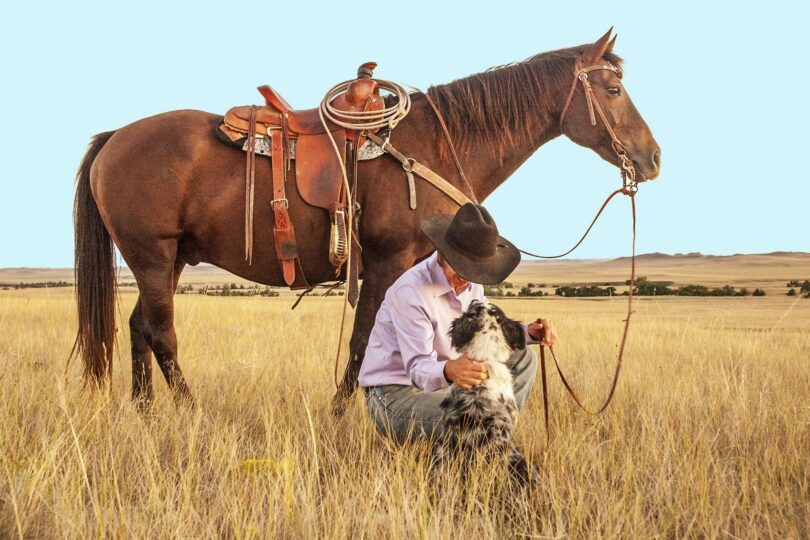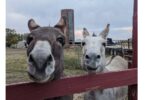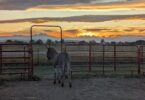Getting Your Pets to Get Along
You’ve always had this vision of your dog and horse as best friends. In your mind, you see early mornings and late nights at the barn with your canine bestie in tow.
Although it seems as if horses and dogs should be able to co-mingle with each other naturally, this isn’t always the case. It takes a fair amount of training and effort to ensure good manners on both sides. This post helps you troubleshoot common issues that can pop up between dogs and horses and how you can work on solving them.
Equine/Canine Behavior Basics
Horses and dogs are similar in that they tend to have intense fight, flight, or freeze responses to stressful situations. Every animal is an individual and will therefore respond to stressors differently.
Your horse and dog may initially perceive the other species as a threat. It’s up to you to help your horse and dog have a positive experience with each other.
Setting the foundation of a solid relationship between your dog and your horse starts with control. The first few introductions absolutely must be done in a highly supervised way.
How to introduce your horse to your dog
One of the best ways to start is by walking your dog on a leash near your horse’s pasture while they are grazing. Ideally, there should be adequate distance between the horse and your dog, so neither feels threatened.
Carefully watch your dog’s behavior for signs of fear or aggression.
These signs may include:
- Barking
- Growling
- Cowering
- Attempts to get away from the situation
- Freezing and staring at the horse
Reward your dog with their favorite treats for calm behavior. If your dog is quiet and attentive, this may be an excellent opportunity to do some obedience training.
On the other hand, if your dog shows signs of fear or aggression, don’t force the issue. Remove your dog from the situation and try again on a different day.
Training an overwhelmed dog is never productive and results in more harm than good.
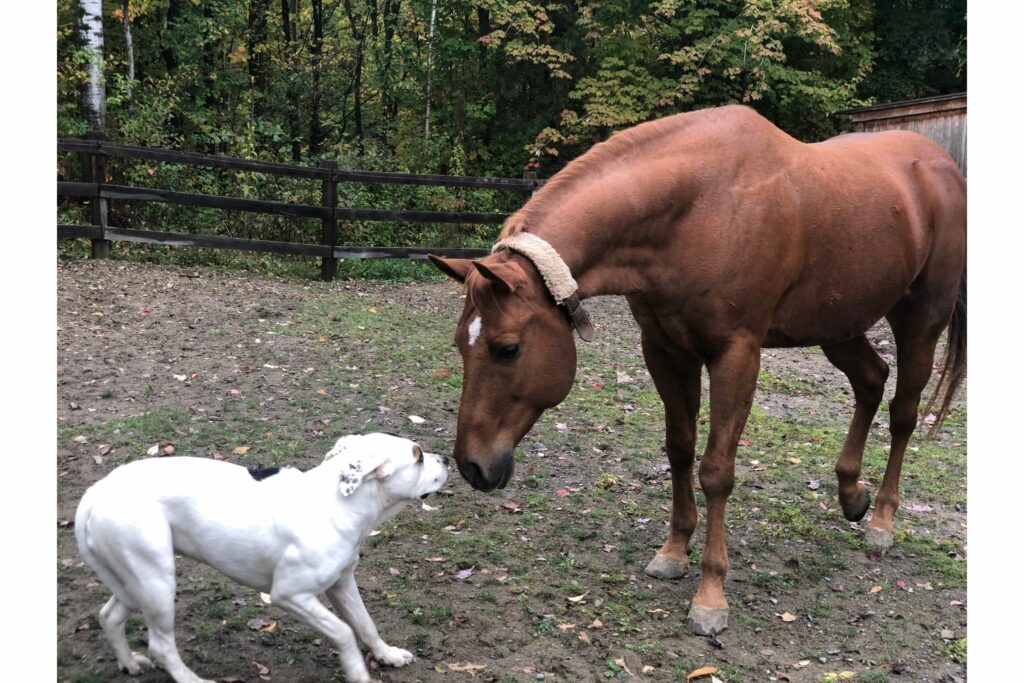
Photo Cred: Canva
If your dog tolerates seeing your horse in the pasture without signs of fear or aggression, you can up the ante a bit.
Next, enlist the help of a friend to hold either your dog, or horse, for a closer introduction.
Interactions between your horse and dog should include both parties in hand with either leash or lead rope so you can quickly intervene if things don’t go well.
These first few introductions are all about control. You want to make this a positive experience for your horse and your dog. If either party shows signs of stress, back off and allow the space and time to cool down.
Focus on Safety
If your dog is reactive or aggressive or your horse does not tolerate your dog, don’t hesitate to bring in a professional. Both dog and horse trainers are experienced in helping animals overcome challenging situations and can guide you in the training process.
Remember that horses have blind spots both directly in front of and behind their bodies. They may kick out and injure you, or your dog, if they are startled by something in their blind spot.
Your dog should never be off their leash around the barn if they don’t have basic obedience skills. They should also demonstrate tolerance to people and horses around the barn without signs of fear or aggression.
Although many dogs can learn to safely co-mingle with horses, some dogs simply can’t—due to high reactivity or previous negative experiences. It’s better to accept that fact and enjoy your dog and horse separately rather than experience the loss of either due to an unfair situation.
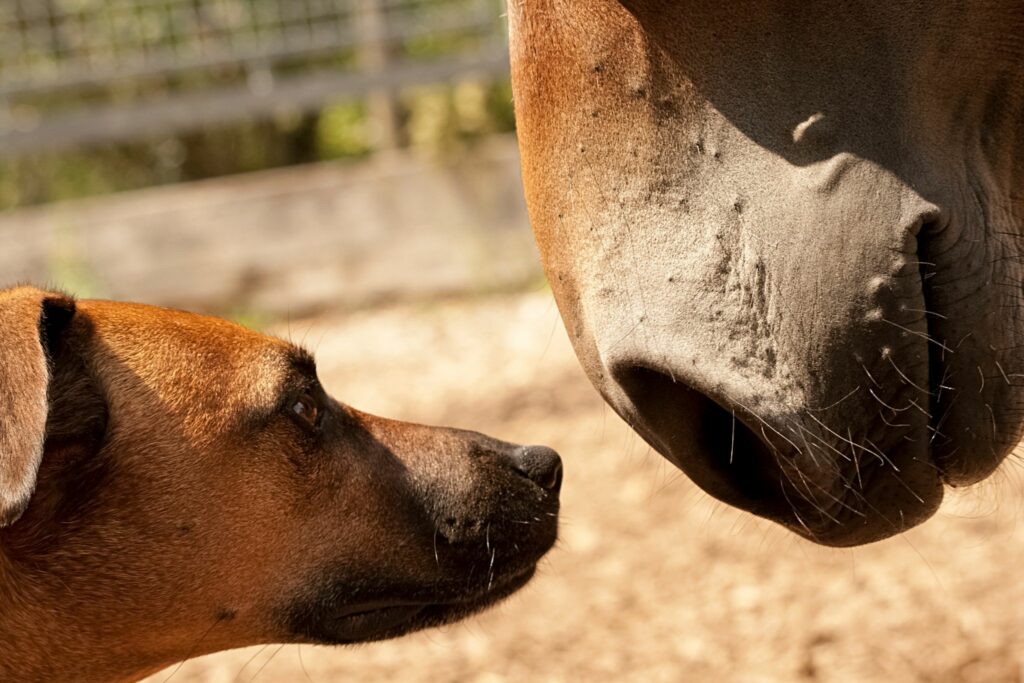
Photo Cred: Canva
Setting Boundaries
Boundaries are essential for both your horse and your dog. They ensure safety by providing each animal with a secure space by avoiding forced interaction and possible injury to either party.
Off Limit Areas
Even if your dog has demonstrated tolerance and obedience at the barn, a few areas should always be off-limits for the safety of both dog and horse. These include:
- Riding arenas
- Inside stalls that contain horses
- Around cross-ties or other areas where horses are closely confined
- Pastures if there is a chance your dog will chase a horse
The bottom line is that you never want to put your dog in a situation where he may startle a horse and sustain a possibly fatal injury.
Physical Barriers
If your dog is not an enthusiastic barker, you could consider having a kennel at the barn to confine him when necessary. Even dogs with exceptional temperament and obedience training need a break at times.
An empty stall may also be a physical barrier if your dog needs some alone time. If your dog loves barking, he may require additional training to tolerate barn life as horses, as well as other humans, may find incessant barking to be irritating.
Good Barn Dog Commands
Before trusting your dog on the loose at the barn, there are several commands he needs to master. These include:
- Strong recall
- Leave it
- Sit
- Lay down
- Off
- Stay
Your dog should know how to politely greet people without jumping, and be able to get along with other dogs. Before letting your dog run free, consider the potential risk posed by vehicles or other barn machinery.
Troubleshooting
Introducing your horse and dog to each other may come with its own set of challenges despite your best efforts. Not all dogs and horses can peacefully coexist.
What do you do if your dog is scared of your horse?
Never force the issue if your dog shows signs of fear. Fear can quickly turn to aggression which never ends well.
If your dog seems overwhelmed, immediately remove him from the situation and try again on a different day and less stressful environment. This may mean initially walking further away from the pasture, or more work on desensitizing your dog to various low-key situations before reintroducing horses.
Always consult an experienced dog trainer if you have concerns about possible fearful or aggressive behavior. They can help you overcome behavioral problems and guide the introduction process.
Remember that it’s OK to love your dog and horse separately. Not all dogs and horses are meant to coexist, and enjoying them independently of each other may be the best decision for all involved.

Photo Cred: Canva
Frequently Asked Questions
Q: Are donkeys OK with dogs?
Donkeys tend to be naturally more territorial than horses and sometimes are used as guard animals. Their territorial tendencies make them somewhat less receptive to canine companions than horses. It may, therefore, take more effort to introduce your dog to a donkey.
Donkeys are highly intelligent and, with the proper training, can be agreeable to interactions with dogs.
You should, however, never leave your dog and donkey unsupervised until they have been appropriately socialized with each other.
Some donkeys, such as wild or feral donkeys, may associate dogs with coyotes. Donkeys have been known to kill dogs, so this is definitely not an area to take any chances.
Q: How do you get a horse used to a dog?
Slowly and carefully. The initial meeting should occur with your horse in the pasture and your leashed dog outside the pasture. If all goes well, you can progress to having someone hold your horse while you keep your dog’s leash and allow them to sniff each other.
Be prepared to intervene if either animal shows signs of stress.
It may take several interactions before they accept each other. And in worst-case scenarios, they may never interact peacefully.
Q: How do you help a scared horse?
Giving your horse a simple command to focus on when scared can help take his mind off whatever is causing his anxiety. It could be a command as simple as asking him to move his head down. The key is keeping it very simple, so he has something on which to focus and can easily “win.”
Sometimes allowing your horse to walk toward whatever scares him and then letting him walk away again helps relieve anxiety. Doing this a few times can be enough to show him that whatever it is that’s scaring him won’t eat him.
Q: How do you calm a scared horse?
Talking in a low, calm voice can be helpful. Avoid sudden movements, and don’t put your horse in a situation that you know will be overwhelming.
Sometimes horses pick up on your nervous energy making the situation worse. But putting off “cool and calm” vibes by a quiet vocal volume and relaxed body language can go a long way toward convincing your horse to follow suit.
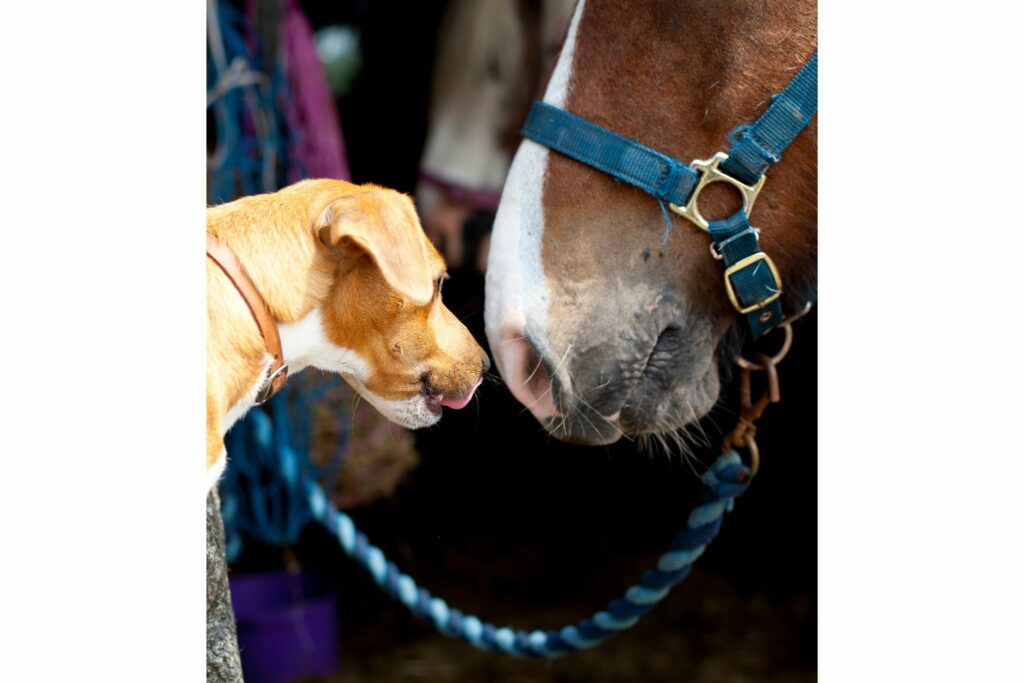
Photo Cred: Canva
Parting Thoughts
If the initial introduction between your horse and dog doesn’t go as well as you’d hoped, don’t give up! Keep the interactions simple and watch for signs of stress on both sides. Sometimes, less is more.
With time and control on your part, your dog and horse can learn to get along.
If things aren’t going well, don’t hesitate to bring a trainer into the mix. And if things still aren’t going well between your equine and canine companions, don’t sweat it! Sometimes it’s just not meant to be, and that’s OK.
Your dog and horse each have exceptional qualities worthy of your love, regardless of whether they share a fondness for each other.
P.S. If you enjoyed this article, trot on over to:
- 6 Tail-Waggin’ Tips for
Trail Riding with Your Dog - Ultimate Beginner’s Guide to Horseback
Trail Riding at Night - Happy Trail Gear Guide: What to Wear Horseback
Trail Riding - 7 Best Satellite Phones for Horse Riders Who Need Help NOW
- The Ultimate Horse Trailering & Packing Checklist
- 6 Best Saddle Pads for
Trail Riding and Happy Horses
Sources
5 expert tips to help you introduce a dog to horses – Horse & Hound (horseandhound.co.uk)
How to Introduce a New Dog to Horses (horseandrider.com)
How to understand donkey behaviour | The Donkey Sanctuary
How to Calm a Hot Horse (horseandrider.com)
5 Ways To Calm A Nervous Horse – COWGIRL Magazine

